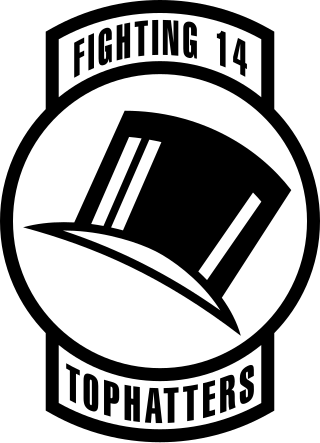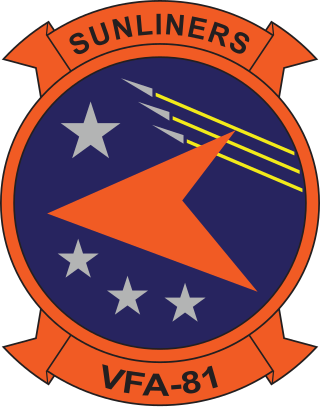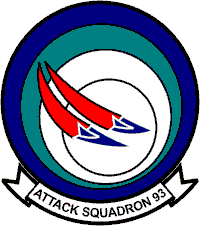
Strike Fighter Squadron 211 (VFA-211), nicknamed the "Fighting Checkmates", is an aviation unit of the United States Navy established in 1945. The squadron is based at Naval Air Station Oceana and is equipped with the Boeing F/A-18E Super Hornet.

The Strike Fighter Squadron 14 (VFA-14) "Tophatters" are a United States Navy fighter attack squadron based at Naval Air Station Lemoore. They fly the F/A-18E Super Hornet, and are the Navy's oldest active squadron, having formed in 1919. Their callsign is Camelot, and their tail code is NG.

Strike Fighter Squadron 102 (VFA-102) is a United States Navy Strike Fighter squadron based at Marine Corps Air Station Iwakuni. Their call sign is Diamond, with the tail code NF, and they fly the F/A-18F Super Hornet.

Strike Fighter Squadron 86 (VFA-86) is a strike fighter squadron of the United States Navy based at Naval Air Station Lemoore, California. The squadron is nicknamed Sidewinders, leading to the call sign Winder. The unit is currently in transition to the F-35C Lightning II and is not assigned to a Carrier Air Wing at this time.

Strike Fighter Squadron 103 (VFA-103), nicknamed the Jolly Rogers, is an aviation unit of the United States Navy established in 1952. VFA-103 flies the F/A-18F Super Hornet and is based at Naval Air Station Oceana, Virginia (US). The squadron's radio callsign is Victory and it is assigned to Carrier Air Wing Seven.

A carrier air wing is an operational naval aviation organization composed of several aircraft squadrons and detachments of various types of fixed-wing and rotary-wing aircraft. Organized, equipped and trained to conduct modern US Navy carrier air operations while embarked aboard aircraft carriers, the various squadrons in an air wing have different but complementary missions, and provide most of the striking power and electronic warfare capabilities of a carrier battle group (CVBG). While the CVBG term is still used by other nations, the CVBG in US parlance is now known as a carrier strike group (CSG).

Fighter Squadron 21 (VF-21) Freelancers was an aviation unit of the United States Navy. Originally established in 1944 as VF-81 it was redesignated VF-13A in 1946, redesignated VF-131 in 1948, redesignated VF-64 in 1950 and redesignated VF-21 on 1 July 1959, it was disestablished on 31 January 1996. It was the third US Navy squadron to have the VF-21 designation.

Fighter Squadron 53, or VF-53Iron Angels was an aviation unit of the United States Navy in service from 20 July 1950 to 29 January 1971. Originally established as reserve squadron VF-721 on 20 July 1950, it was redesignated as VF-141 on 4 February 1953 and then redesignated as VF-53 on 15 October 1963. The squadron was disestablished on 29 January 1971. It was the fourth US Navy squadron to be designated as VF-53.

Strike Fighter Squadron 81 (VFA-81), also known as the "Sunliners", is a United States Navy F/A-18E Super Hornet strike fighter squadron stationed at Naval Air Station Oceana. They are currently assigned to Carrier Air Wing 1. Their mission is to conduct prompt and sustained combat operations from the sea. The squadron was originally designated VA-66 on 1 July 1955, was redesignated VF-81 the same day, redesignated VA-81 on 1 July 1959, and finally redesignated VFA-81 on 4 February 1988.

Strike Fighter Squadron 83 (VFA-83), also known as the "Rampagers", are a United States Navy F/A-18E Super Hornet fighter squadron stationed at Naval Air Station Oceana. They are a part of Carrier Air Wing 3, their tailcode is AC and their radio callsign is Ram.

Strike Fighter Squadron 192 (VFA-192), also known as the "World Famous Golden Dragons", are a United States Navy F/A-18E Super Hornet fighter squadron stationed at NAS Lemoore.

VA-106 was an Attack Squadron of the U.S. Navy. Originally established as Bomber-Fighter Squadron Seventeen (VBF-17) on 2 January 1945, it was redesignated Fighter Squadron Six B (VF-6B) on 15 November 1946, redesignated VF-62 on 28 July 1948, redesignated Attack Squadron 106 (VA-106) on 1 July 1955, it was disestablished on 7 November 1969. It was the second US Navy squadron to be designated VA-106.

VA-93 was an Attack Squadron of the U.S. Navy. It was established as Fighter Squadron VF-93 on 26 March 1952, and redesignated as VA-93 on 15 September 1956. It was disestablished 30 years later on 31 August 1986. The squadron's nickname was the Blue Blazers from 1954 to 1976 and the Ravens thereafter.

VA-153 was an Attack Squadron of the U.S. Navy. During a 1949 reorganization of the Naval Air Reserve, a Fighter Squadron at NAS New York was redesignated Fighter Squadron VF-831. It was called to active duty on 1 February 1951. The squadron was redesignated as VF-153 on 4 February 1953, and finally as VA-153 on 15 December 1956. It was disestablished on 30 September 1977. The squadron's nickname was the Blue Tail Flies from 1953 onward.

Attack Squadron 15 (VA-15), nicknamed the Valions, was an aviation unit of the United States Navy. It was established as Torpedo Squadron 4 (VT-4) on 10 January 1942, redesignated VA-2A on 15 November 1946, and finally redesignated VA-15 on 2 August 1948. The squadron was disestablished on 1 June 1969, after 27 years of service.

VA-44, nicknamed the Hornets, was an Attack Squadron of the US Navy. The squadron was established as Fighter Squadron VF-44 on 1 September 1950, and redesignated VA-44 on 1 January 1956. It was disestablished on 1 May 1970. It was the second squadron to be designated VA-44, the first VA-44 was disestablished on 8 June 1950.

Attack Squadron TWELVE, also known as the "Flying Ubangis" or "Clinchers", was an attack squadron of the United States Navy active during the Cold War. From their home port at Naval Air Station Cecil Field in Florida, the squadron made more than thirty major overseas deployments aboard aircraft carriers, primarily flying A-4 Skyhawk and later the A-7E Corsair II, including two combat tours in the Vietnam War.

Carrier Air Wing Thirteen (CVW-13) was a carrier air wing of the United States Navy established for a short period at the end of the Cold War. There were three previous units which had been named Carrier Air Group Thirteen (CVG-13), dating as far back as 1942, though each of these units has a distinct lineage.

Fighter Squadron 96, or VF-96Fighting Falcons was an aviation unit of the United States Navy in service from 1962 to 1975. When assigned to Carrier Air Wing Nine (CVW-9) their tailcode was NG, and their radio callsign was Showtime. Originally established as United States Naval Reserve squadron VF-791Fighting Falcons on 20 July 1950 it was redesignated VF-142 after becoming a regular squadron on 4 February 1953. It was re-designated VF-96 on 1 June 1962 and disestablished on 1 December 1975.

Fighter Squadron 22 or VF-22 was an aviation unit of the United States Navy. Originally established as Bombing Fighting Squadron 74A (VBF-74A) on 1 May 1945, it was redesignated VBF-74 on 1 August 1945, redesignated as VF-2B on 15 November 1946, redesignated as VF-22 on 1 September 1948, it was disestablished on 6 June 1958.



























